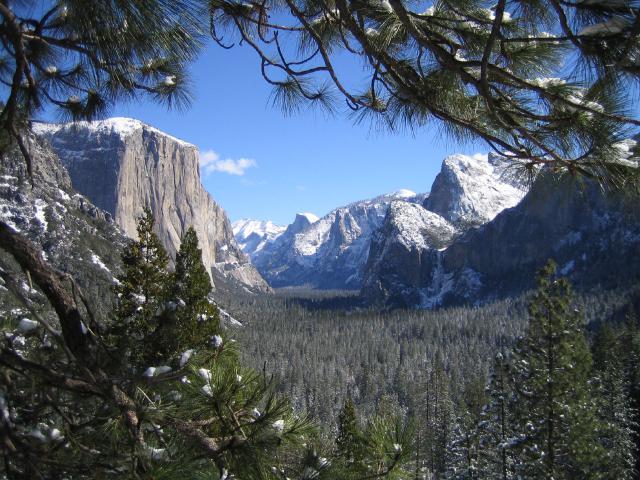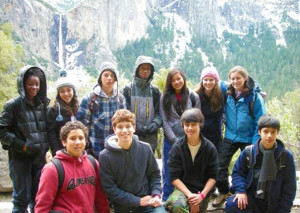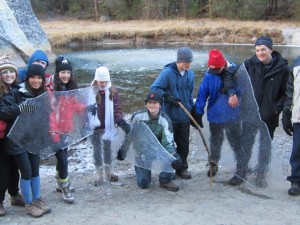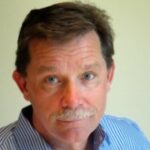We looked around, startled to hear an unrecognized female voice rise into Yosemite’s still wintertime forest. My class and I were three days into our trip and far from the few casual hikers that populate the valley floor in wintertime. We were not expecting company. In fact, we had traveled from Southern California during the snowy days of January specifically so that we could be relatively alone with nature. Well, at least I had, however it is probable that my adolescent students had other, more social, plans. I continued on, leaving post-holes in the deep snow, dismissing the voice as having reflected from the encircling granite walls or wafting down from skiers high above. Only moments later my reverie was again interrupted, but this time I was quick enough to spot the source. Several yards back Amanda was flirting, playing, and laughing with a classmate—hardly a surprise for most teenagers, but it was a sound, a voice, and a level of comfort with her classmates I had never heard or observed during her three years in my classroom.
We all watched as over the following days of outdoor activity Amanda flowered like a winter rose. Petal after petal of her personality ever so tentatively emerged. First, conversation, then play, and finally a resilient wit revealed that while she had been silent in our prior experience, she had been watching. She wielded her knowledge of her classmates with a generous shy humor as she made verbal contact with most of classmates in a manner as surprising as it was rewarding to watch. By day four, she lifted her eyes to mine, making eye contact for the first time ever, and gifted me with this quiet gem: “We should spend more time outdoors.”
Her classmates were as captivated by this flowering as I was, and a community garden of caring humans bloomed around her precious, but still vulnerable, growth. Normal patterns of adolescent social interaction were fundamentally altered, as pointed humor, stinging sarcasm, and verbal targeting were set aside. Our one bully went completely silent, compelled by his classmates’ fierce looks to control himself, while Amanda stumbled on her journey to social skills. As Amanda made this journey of healthy connection, nature—experienced out of the classroom—was her primary navigator; an essential foundation of her ability to manage her diagnosis of Asperger’s syndrome. Everyone in the class made the journey from individual to becoming a member of a community responsible to one another. Birgit’s journey to human connection was powerful to witness, yet she is but one flower in the garden, my class but one field on a vast plain.
Access for All Students to Outdoor & Environmental Education
I can hear the chorus of voices pushing back: What about less privileged schools? What about the dangers of time spent outdoors—sun, dehydration, discomfort, bears, or peeing in the woods? How can we step away from content learning?
Educators are successfully surmounting each of these challenges every day across California. My school received generous scholarships so that every student could go regardless of financial status. More affluent parents quietly sent checks my way, and I applied for grants. The money is there if getting outdoors is the priority that it should be given the research support regarding the health and learning benefits of such activity. With regard to managing outdoor dangers, the dangers of spending too much time indoors are greater and well documented by researchers like Richard Louv. With regard to the pressure on educators to ‘cover’ enormous quantities of academic content, we will never learn all there is to know. Moreover, one does not have to go to Yosemite (delightful as that was), as meaningful outdoor education can take place anywhere there is a door to exit, a community to explore, or a park nearby. Enabling partnerships are as close as your local nonprofits.
Environmental education has long been associated with outdoor education, but our new state standards (CCSS and NGSS) give us an opportunity to reach for full integration of nature-based education into the formal classroom. More to the point, we need to consistently envision the outdoors as a rich learning space; to make learning outdoors, environmental literacy, and nature-based projects a primary strategy to educate young people in this era of Nature Deficit Disorder. California’s Blueprint for Environmental Literacy is replete with sensible suggestions that support a vision of coordinated and mutually reinforcing EE activity both in- and out-of-doors.
But what are we to make of our, otherwise stellar, Science Curriculum Framework when the instructional strategies section includes no mention of the outdoors as an engaging instructional strategy? By contrast, the digital learning realm is generous in this area, with a subsection devoted exclusively to digitally supported education. A search of the document reveals a wealth of references to the words “computer”, “technology”, and “online”. The word “outdoor” or “outdoors” does not appear.
Amanda would be disappointed to know that our state does not consider the outdoors to be “engaging.”
Fortunately, an opportunity exists to make public comment (through January 19th) directly to California’s Department of Education. Amanda remains shy and soft spoken; ethical people should consider speaking for her and all students. Supporting all students in this case means making the case for health and learning by integrating outdoor activity into our formal curriculum at every opportunity. Here is your chance to contribute!
Please link to the California Science Curriculum Framework and opportunities to learn more about the process today!






2 Responses
Kurt,
I felt like I was walking with you on your social/emotional/environmental/educational journey with your students. Thanks for providing a flashlight rather than a hammer (to borrow a metaphor that Patricia Rucker, member,State Board of Education applied to the new state assessments) to illuminate the benefits of getting students outdoors! With support from in-classroom instruction that uses the environment as context and great teacher professional learning about how to incorporate environmental themes into their teaching, we are moving toward the paragigm shift of all students becoming environmental literate. Thank you for your leadership and great writing!
Kurt,
Thanks for painting such a beautiful picture of one student who represents just one of the tens-of-thousands who can benefit socio-emotionally from from experiences in the natural world. Opening that door for Amanda, and millions of other students in California and across the country, translates past the interpersonal skills into excitement, enthusiasm for learning, and a desire to discover more about the world around them.
Outdoor learning opportunities, learning how natural systems work, and investigating how humans interact with the environment can, and should be, an important part of implementing the Next Generation Science Standards (NGSS) in California.
The current draft of California’s new Science Curriculum Framework identifies strong connections between the NGSS and California’s adopted Environmental Principles and Concepts (EP&Cs). We should all work together to assure that California’s new Blueprint for Environmental Literacy is given the support it requires to be fully implemented, assuring that our current generation of California students become environmentally literate citizens.